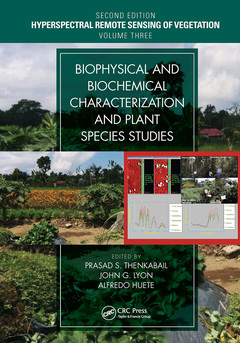Description
Biophysical and Biochemical Characterization and Plant Species Studies (2nd Ed.)
Hyperspectral Remote Sensing of Vegetation, Second Edition Series
Coordinators: Thenkabail Prasad S., Lyon John G., Huete Alfredo
Language: English
Subjects for Biophysical and Biochemical Characterization and Plant...:
Keywords
Hyperspectral Data; Red Edge Inflection Point; Broad-band data from sensors; Landsat ETM+; Red Edge; Cloud computing; Hyperspectral Remote Sensing; Crop water use and water productivity modeling and mapping; RGB Camera; Hyperspectral sensor systems; Linear Spectral Mixture Model Analysis; Spaceborne hyperspectral EO-1 Hyperion pre-processing; Red Edge Normalized Difference Vegetation; UAV and field hyperspectral data; SMA; crop moisture assessments; Hyperspectral Image; terrestrial vegetation; NDWI; crop yield modeling; Normalized Difference Spectral Index; ITCs; biochemical property characterization; Edge NDVI; Hyperspectral Reflectance Data; Narrow Band Indices; Red Edge NDVI; Spectral Indices; GPP Estimation; NDVI Relationship; HNBs; Green LAI; Ecophysiological Functioning; Hyperspectral Vegetation Indices; PLS Model; Hyperspectral Image Data
Publication date: 01-2023
· 17.8x25.4 cm · Paperback
Publication date: 12-2018
· 17.8x25.4 cm · Hardback
Description
/li>Contents
/li>Biography
/li>
Written by leading global experts, including pioneers in the field, the four-volume set on Hyperspectral Remote Sensing of Vegetation, Second Edition, reviews existing stateof- the-art knowledge, highlights advances made in different areas, and provides guidance for the appropriate use of hyperspectral data in the study and management of agricultural crops and natural vegetation.
Hyperspectral remote sensing or imaging spectroscopy data has been increasingly used in studying and assessing the biophysical and biochemical properties of agricultural crops and natural vegetation. Volume III, Biophysical and Biochemical Characterization and Plant Species Studies demonstrates the methods that are developed and used to study terrestrial vegetation using hyperspectral data. This volume includes extensive discussions on hyperspectral data processing and how to implement data processing mechanisms for specific biophysical and biochemical applications such as crop yield modeling, crop biophysical and biochemical property characterization, and crop moisture assessments. The concluding chapter provides readers with useful guidance on the highlights and essence of Volume III through the editors? perspective.
Key Features of Volume III:
- Covers recent abilities to better quantify, model, and map plant biophysical, biochemical water, and structural properties.
- Demonstrates characteristic hyperspectral properties through plant diagnostics or throughput phenotyping of plant biophysical, biochemical, water, and structural properties.
- Establishes plant traits through hyperspectral imaging spectroscopy data as well as its integration with other data, such as LiDAR, using data from various platforms (ground-based, UAVs, and earth-observing satellites).
- Studies photosynthetic efficiency and plant health and stress through hyperspectral narrowband vegetation indices.
- Uses hyperspectral data to discriminate plant species and\or their types as well as their characteristics, such as growth stages.
- Compares studies of plant species of agriculture, forests, and other land use\land cover as established by hyperspectral narrowband data versus multispectral broadband data.
- Discusses complete solutions from methods to applications, inventory, and modeling considering various platform (e.g., earth-observing satellites, UAVs, handheld spectroradiometers) from where the data is gathered.
- Dwells on specific applications to detect and map invasive species by using hyperspectral data.
Section I: Vegetation Biophysical and Biochemical Properties 1. Recent Developments in Remote Estimation of Crop Biophysical and Biochemical Properties at Various Scales 2. Hyperspectral Assessment of Ecophysiological Functioning for Diagnostics of Crops and Vegetation 3. Spectral and Spatial Methods for Hyperspectral and Thermal Image-Analysis to Estimate Biophysical and Biochemical Properties of Agricultural Crops 4. Spectral and 3D Nonspectral Approaches to Crop Trait Estimation Using Ground and UAV Sensing 5. Photosynthetic Efficiency and Vegetation Stress Section II: Plant Species Identification and Discrimination 6. Crop Type Discrimination Using Hyperspectral Data: Advances and Perspectives 7. Identification of Canopy Species in Tropical Forests Using Hyperspectral Data 8. Characteristics of Tropical Tree Species in Hyperspectral and Multispectral Data 9. Detecting and Mapping Invasive Plant Species Using Hyperspectral Data 10. Visible, Near Infrared, and Thermal Spectral Radiance On-Board UAVs for High-Throughput Phenotyping of Plant Breeding Trials Section III: Conclusions 11. Fifty Years of Advances in Hyperspectral Remote Sensing of Agriculture and Vegetation—Summary, Insights, and Highlights of Volume III: Biophysical and Biochemical Characterization and Plant Species Studies
Dr. Prasad S. Thenkabail, Research Geographer-15, U.S. Geological Survey (USGS), is a world-recognized expert in remote sensing science with multiple major contributions in the field sustained over more than 30 years. He obtained his PhD from the Ohio State University in 1992 and has over 140+ peer-reviewed scientific publications. Dr. Thenkabail has conducted pioneering cutting-edge research in the area of hyperspectral remote sensing of vegetation (https://www.usgs.gov/wgsc/GHISA/) and in that of global croplands and their water use for food security (www.croplands.org). Dr. Thenkabail’s contributions to series of leading edited books on remote sensing science along with his research and other contributions in the subject places his as a noted global expert in remote sensing science. He edited three-volume book entitled Remote Sensing Handbook published by Taylor and Francis, with 82 chapters and more than 2000 pages, widely considered a "magnus opus" encyclopedic standard reference for students, scholars, practitioners, and major experts in remote sensing science. He has recently completed editing four-volume Hyperspectral Remote Sensing of Vegetation. He has also edited a book on Remote Sensing of Global Croplands for Food Security. He is currently an editor-in-chief of the Remote Sensing open access journal published by MDPI; an associate editor of the journal Photogrammetric Engineering and Remote Sensing (PERS) of the American Society of Photogrammetry and Remote Sensing (ASPRS); and an editorial advisory board member of the International Society of Photogrammetry and Remote Sensing (ISPRS) Journal of Photogrammetry and Remote Sensing. NASA and USGS selected him on the Landsat Science team (2007-2011). Earlier, he served on the editorial board of Remote Sensing of Environment for many years (2007–2017). He has won three best paper awards from ASPRS for his publications in PE&RS.




